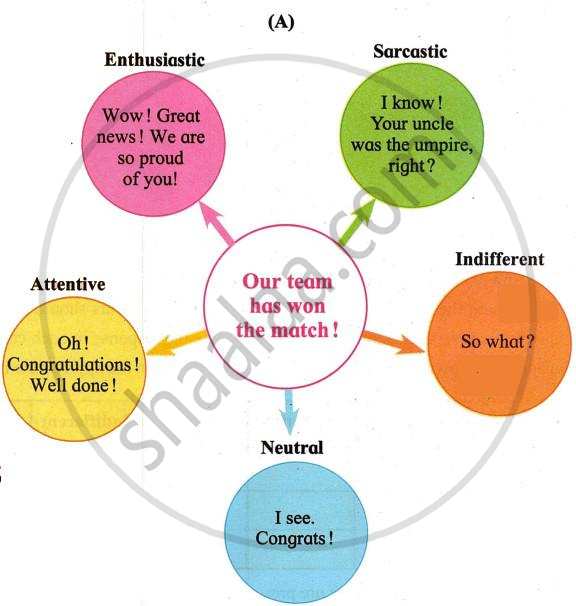Advertisements
Advertisements
Question
Read aloud the central statement and the responses in A and B.


Now you have five conversations each for both 'A' and 'B'. Play a guessing game using these conversations. Different pairs of students should present these different conversations in the class. Others rate the response in each conversation using the following table, by putting a tick mark (✓) in the appropriate box.
| Enthusiastic | Attentive | Neutral | Indlfferent | Sarcastic | |
| Words | |||||
| Gestures | |||||
| Tone |
See that all types of response are presented in the activity.
Solution
Identify the Responses for Each Statement
The responses in images A and B are categorized into different tones:
- Our team has won the match!
- Enthusiastic: "Wow! Great news! We are so proud of you!"
- Attentive: "Oh! Congratulations! Well done!"
- Neutral: "I see. Congrats!"
- Indifferent: "So what?"
- Sarcastic: "I know! Your uncle was the umpire, right?"
- Raju has lost his wallet.
- Enthusiastic: "Oh! No! How terrible! Can we help?"
- Attentive: "Oh, really! How sad!"
- Neutral: "Oh, I see."
- Indifferent: "Such things happen."
- Sarcastic: "What else do you expect! He is such a careful person!"
The following table should be completed based on how each type of response is conveyed through Words, Gestures, and Tone.
- You can tell the difference between each type of reaction by the words that are spoken, the body language and facial expressions that are used, and the tone of voice that is used.
- A sarcastic answer might sound over the top or like it's making fun of the person.
- A flat or uninterested tone could be used to say that you don't care.
- Responses that are enthusiastic are lively and outspoken.
- When someone responds carefully, they show care, but not as much as when they respond enthusiastically.
- Responses that are neutral are straightforward and don't show any feeling.
Notes
Students should present these conversations in the class. While other students rate by putting a tick mark in the appropriate box.
